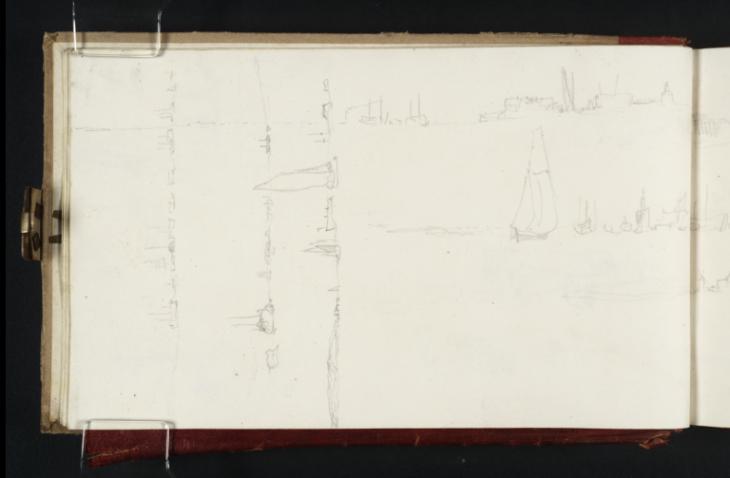Joseph Mallord William Turner Groups of Ships, and a View of Queenborough c.1821
Image 1 of 2
Joseph Mallord William Turner,
Groups of Ships, and a View of Queenborough
c.1821
Joseph Mallord William Turner 1775–1851
Folio 5 Verso:
Groups of Ships, and a View of Queenborough c.1821
D17374
Turner Bequest CXCIX 5a
Turner Bequest CXCIX 5a
Pencil on white wove paper, 112 x 190 mm
Partial watermark ‘R Bar | 18’
Partial watermark ‘R Bar | 18’
Accepted by the nation as part of the Turner Bequest 1856
References
1909
A.J. Finberg, A Complete Inventory of the Drawings of the Turner Bequest, London 1909, vol.I, p.607, CXCIX 5 a, as ‘Do.’ i.e. ‘Groups of ships’.
Continuing a thematic interest explored extensively in the present sketchbook, here Turner observes a number of panoramic views of waterways densely populated with ships, as stipulated by Finberg.1
Two of these views are made horizontally, according to the foliation of the sketchbook. The first stretches across the top edge of the page, although the main figurative elements are focused at right. A cluster of boats is described at centre, distinguished by four masts which stand erect above the tangle. To the right of this Turner renders a port, combining architectural shapes with further indications of shipping. Out to the left, beyond the group of boats, stretches open water, and the slight indication of distant topography, although all of this is overlapped by three drawings made with the sketchbook turned vertically.
Directly below is a second horizontal drawing, composed across both this and the facing page on folio 6 recto (D17375). The portion on this sheet displays a group of boats in the mid distance, which straddles the gutter. A larger vessel is described to the left, with open water beyond. This more elaborate boat boasts a tall, unfurled sail, and sits towards the centre of this section of the split composition. Beneath this drawing a small slice of a sketch is visible which is predominantly composed on the facing page. For more information about this drawing, which seems to describe a view of Queenborough on the River Swale, see the entry for that sheet. For additional impressions of the same view, see folios 8 recto, 85 verso and 86 verso (D17378, D17497, D17499).
The sketches composed with the book turned vertically also display views busily populated with vessels. As with all of the sketches on this sheet, they adhere to a linear form. Turner observes the boats in relation to the waterline, paying little attention to topographic context. With the page oriented in this way, the topmost drawing is concerned with a packed horizon of small vessels, depicted nose to tail across three quarters of the width of the paper. The row below stretches to the same length but offers a less compacted group of boats, and a more diverse range of examples in terms of size and distance from the artist. The sketch third from the top is the most compositionally elaborated and balanced. At far left the topographical characteristics of the land are clearly delineated, rising above water level in the form of rippling pencil lines. To the immediate right of this land mass, a small collection of buildings are evident on the shore. The wide, open space of water at right is populated with a range of boats, from light craft with tall, slim sails, to simple, squat examples with very little elaborative paraphernalia.
Maud Whatley
January 2016
How to cite
Maud Whatley, ‘Groups of Ships, and a View of Queenborough c.1821 by Joseph Mallord William Turner’, catalogue entry, January 2016, in David Blayney Brown (ed.), J.M.W. Turner: Sketchbooks, Drawings and Watercolours, Tate Research Publication, February 2017, https://www


